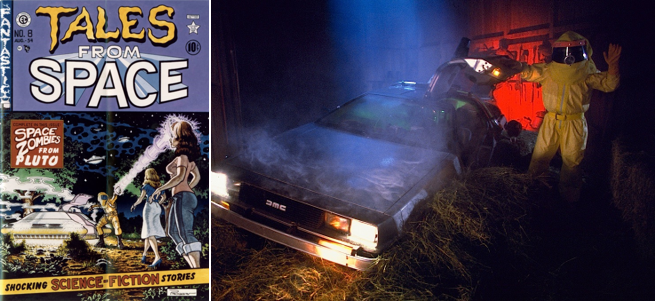
When something looks or sounds “futuristic” it can include a wide range of interesting and unique styles that strike us as being ahead of their time. Speculating about the future for most people is an everyday occurrence. We plan trips, schedule meetings, and fundamentally understand that what is true or conventional today may not be in the future. In that way, people are always wondering about what things will look like as technology and culture progresses. Many films and TV shows from Spongebob to the Terminator have taken on the idea of representing what our future will look like. The 1985 film Back to the Future looks at the changes culturally, technologically, and visually that have taken place in the 30 year span from 1955 to 1985. In that 30 year span we have the moon landing, the invention of the cassette player, video games and hundreds of other technological developments that shaped the way things looked and how people behaved. Although changing technologies were the driving force of change, in many ways the way the future turned out was a self-fulfilling extension of what we expected. Back to the future argues that the reason they had “futuristic” looking cars and cultures in 1985 compared to 1955 is because they are mimicking the way science fiction and media in that time predicted that it would look.
The Delorean DMC-12 was the car chosen to represent Doc Brown’s time machine for no reason other than it’s looks. The car itself was heavy, underpowered and poorly made, but its stainless-steel body, sleek design and gull wing doors provided the perfect platform for a car that was supposed to look like it was from the future. The film makers reference this in the scene pictured above when Marty first goes back in time and crashes into a barn. In a perfect storm of misunderstandings, Marty, still in his radiation suit, exits the car whose obscured wheels and unorthodox door make it look exactly like the space ship in the onlooking boy’s comic book “space zombies from Pluto.” 1955 was the beginning of humanities ventures into outer space, and our obsession with space travel only grew as the space race began, giving rise to whole new genres of science fiction, and expanding the realm of what humans thought was possible. As technology changed, so did the speculation and prediction of the future in science fiction, and these predictions are what people based their designs on as time went by. Although the Delorean is far from an actual space ship, it’s looks are purposely reminiscent of early predictions of what a space ship would have looked like. If you compare the way a car looked in 1955 with the way cars looked in 1985, you’ll notice a transition away from the round bubbly looks with chrome accents to a more sharp, angular body style that looks almost alien.
In Jean Baudrillard’s 1981 Treatise Simulcra and Simulation he also argues that eventually it becomes difficult to determine whether the advancement of technology or the idea of looking “futuristic” is predicted by science fiction, or if the creative minds of science fiction writers end up steering technology and culture in different directions by changing people’s expectation of the future. “they [science fiction works] no longer constitute the imaginary in relation to the real, they themselves are the anticipation of the real—they are immanent, and thus leave no room for imaginary transcendence.”(Baudrillard 122) So, in the scene pictured above filmmakers create the Delorean to look futuristic and mimic the comic book because they are explaining that when something is defined as futuristic looking it is because it is a current representation of past speculation.
Works Cited:
Baudrillard, Jean, and Sheila Faria. Glaser. Simulacra and Simulation. Univ. of Michigan Press, 2014.